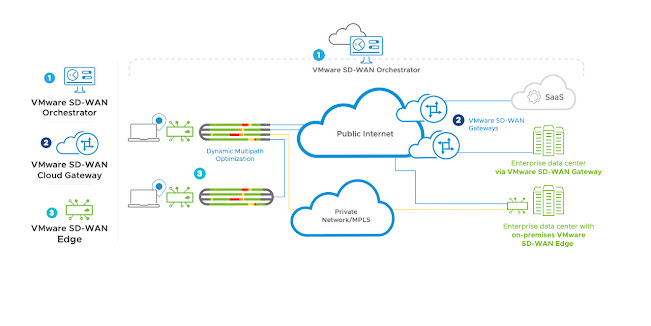"High Away Blues Nr 1" or Challenges in Edge High Availability Part 1: VRRP HA
Configuring different High Availability Features one Branch Setup in my lab was using an MPLS CE-Router and VRRP to allow a restricted Fault Tolerance.
When
the VMware SD-Wan Edge goes down, there is still a working MPLS
connectivity via the CE Router, which means the Branch in that case
behaves like a NSD (Non-SD-Wan enabled site) and you need to have a
forwarding via either a hybrid Partner Gateway or Hybrid HUB site to
still be able to reach all necessary destinations.
The MPLS-facing CE-Router in my case is a Cisco IOS L3 Router, MPLS connectivity for that customer is using OSPF
On the VCO the Edge BR-20 has the corresponding VRRP-setting
GE1 is the Link from Edge to the CE-Router using pt-2-pt OSPF
In the WAN Settings GE1 is marked as User Defined Wan Overlay of type Private Wired named MPLS-Cust-2
The necessary Enable Wan Overlay Flag is correctly set, telling the Edge to also build Overlay tunnels to Gateways using that connection towards MPLS via the CE-Router
BUT ...
Unfortunately the MPLS Overlay does not come up with that configuration
But we see that our VRRP configuration is also detected and up
When
using the List Paths in the Remote Diagnostics section we only see
overlay tunnel built to 2 Gateways via the 110.1.1.0/24 Internet
connection
So now we have a seemingly correct configuration, but no Overlay tunnels over MPLS
Let´s have a look into one of the MUST-HAVE (and MUST-READ) documents
"SD-WAN Reference Design Guide" White Paper April 2019
On
page 7 we find some useful information regarding requirements so that
Tunnel initiation message will be sent out and reaches the defined
SD-Wan Gateways
So according to the info found here we specified all the necessary information for Wan Overlay
Looking
further into the Edge BR-20 we can find all necessary MPLS
destinations learned via OSPF and primarily pointing to the GE1
interface towards the MPLS CE-Router
Looking further into the above mentioned Reference Guide you can find on Page 8:
But again we have 2 Gateways as remote peers connected to the correct MPLS/vrf as well, so that requirement is given in our case
However the only thing missing is the automatic Default Route pointing out interface GE1
Unfortunately I did not get any useful information from the official VMware SD-WAN documentation .
After some useless tries by comparing route table with other working SD-WAN Edges, I found the solution.
Even
though we have an OSPF pt-2-pt Interface on GE1 with only a single OSPF
learned neighbor, we need to configure the neighbor address as Gateway
address in the interface configuration.
Only then the necessary Default Route out GE1 will be automatically set-up.
Using
the default route out of an Wan Overlay enabled interface tunnel
initiation messages will be sent and when they reach the selected
Gateways Overlay tunnels via interface GE1 and MPLS will be set up.
Now we have the necessary Tunnels 2 each to our 2 selected Gateways





Comments
Post a Comment